《DSP using MATLAB》Problem 8.40

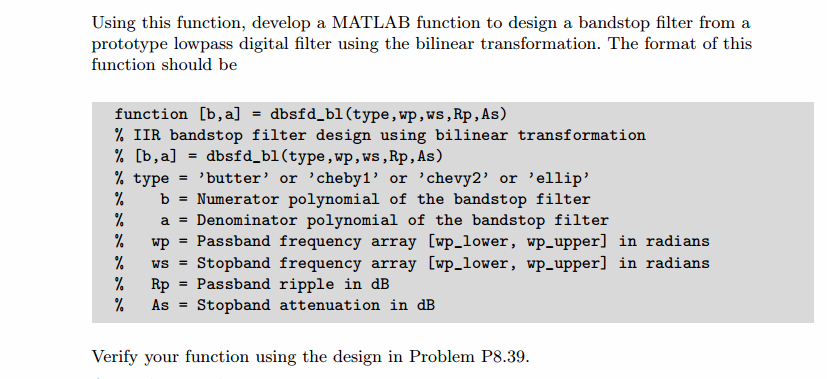

代码:
function [wpLP, wsLP, alpha] = bs2lpfre(wpbs, wsbs)
% Band-edge frequency conversion from bandstop to lowpass digital filter
% -------------------------------------------------------------------------
% [wpLP, wsLP, alpha] = bs2lpfre(wpbs, wsbs)
% wpLP = passband edge for the lowpass digital prototype
% wsLP = stopband edge for the lowpass digital prototype
% alpha = lowpass to bandstop transformation parameter
% wpbs = passband edge frequency array [wp_lower, wp_upper] for the bandstop
% wsbs = stopband edge frequency array [ws_lower, ws_upper] for the bandstop
%
% % Determine the digital lowpass cutoff frequencies:
wpLP = 0.2*pi;
K = tan((wpbs(2)-wpbs(1))/2)*tan(wpLP/2);
beta = cos((wpbs(2)+wpbs(1))/2)/cos((wpbs(2)-wpbs(1))/2);
alpha1 = -2*beta*K/(K+1);
alpha2 = (1-K)/(K+1); alpha = [alpha1, alpha2]; wsLP = -angle((exp(-2*j*wsbs(1))+alpha1*exp(-j*wsbs(1))+alpha2)/(alpha2*exp(-2*j*wsbs(1))+alpha1*exp(-j*wsbs(1))+1))
wsLP = angle((exp(-2*j*wsbs(2))+alpha1*exp(-j*wsbs(2))+alpha2)/(alpha2*exp(-2*j*wsbs(2))+alpha1*exp(-j*wsbs(2))+1))
function [b, a] = cheb1bsf(wpbs, wsbs, Rp, As)
% IIR bandstop Filter Design using Chebyshev-1 Prototype
% -----------------------------------------------------------------------
% [b, a] = cheb1bsf(wp, ws, Rp, As);
% b = numerator polynomial coefficients of bandstop filter, Direct form
% a = denominator polynomial coefficients of bandstop filter, Direct form
% wp = Passband edge frequency array [wp_lower, wp_upper] in radians;
% ws = Stopband edge frequency array [ws_lower, ws_upper] in radians;
% Rp = Passband ripple in +dB; Rp > 0
% As = Stopband attenuation in +dB; As > 0
%
%
% Determine the digital lowpass cutoff frequencies:
wpLP = 0.2*pi;
K = tan((wpbs(2)-wpbs(1))/2)*tan(wpLP/2);
beta = cos((wpbs(2)+wpbs(1))/2)/cos((wpbs(2)-wpbs(1))/2);
alpha1 = -2*beta*K/(K+1);
alpha2 = (1-K)/(K+1); alpha = [alpha1, alpha2]; wsLP = -angle((exp(-2*j*wsbs(1))+alpha1*exp(-j*wsbs(1))+alpha2)/(alpha2*exp(-2*j*wsbs(1))+alpha1*exp(-j*wsbs(1))+1))
wsLP = angle((exp(-2*j*wsbs(2))+alpha1*exp(-j*wsbs(2))+alpha2)/(alpha2*exp(-2*j*wsbs(2))+alpha1*exp(-j*wsbs(2))+1)) % Compute Analog Lowpass Prototype Specifications: Inverse Mapping for frequencies
T = 1; Fs = 1/T; % set T = 1
OmegaP = (2/T)*tan(wpLP/2); % Prewarp(Cutoff) prototype passband freq
OmegaS = (2/T)*tan(wsLP/2); % Prewarp(cutoff) prototype stopband freq % Design Analog Chebyshev-1 Prototype Lowpass Filter:
[cs, ds] = afd_chb1(OmegaP, OmegaS, Rp, As); % Bilinear transformation to obtain digital lowpass:
[blp, alp] = bilinear(cs, ds, Fs); % Transform digital lowpass into bandstop filter
Nz = [alpha2, alpha1, 1]; Dz = [1, alpha1, alpha2];
[b, a] = zmapping(blp, alp, Nz, Dz);
%% ------------------------------------------------------------------------
%% Output Info about this m-file
fprintf('\n***********************************************************\n');
fprintf(' <DSP using MATLAB> Problem 8.40.2 \n\n'); banner();
%% ------------------------------------------------------------------------ % Digital Filter Specifications: Chebyshev-1 bandstop
wsbs = [0.35*pi 0.65*pi]; % digital stopband freq in rad
wpbs = [0.25*pi 0.75*pi]; % digital passband freq in rad delta1 = 0.05; % passband tolerance, absolute specs
delta2 = 0.01; % stopband tolerance, absolute specs Rp = -20 * log10( (1-delta1)/(1+delta1)) % passband ripple in dB
As = -20 * log10( delta2 / (1+delta1)) % stopband attenuation in dB Ripple = 10 ^ (-Rp/20) % passband ripple in absolute
Attn = 10 ^ (-As/20) % stopband attenuation in absolute % --------------------------------------------------------
% method 1: cheb1bsf function
% --------------------------------------------------------
fprintf('\n*******Digital bandstop, Coefficients of DIRECT-form***********\n');
[bbs, abs] = cheb1bsf(wpbs, wsbs, Rp, As)
[C, B, A] = dir2cas(bbs, abs) % Calculation of Frequency Response: [dbbs, magbs, phabs, grdbs, wwbs] = freqz_m(bbs, abs); % ---------------------------------------------------------------
% find Actual Passband Ripple and Min Stopband attenuation
% ---------------------------------------------------------------
delta_w = 2*pi/1000;
Rp_bs = -(min(dbbs( 1:1:ceil(wpbs(1)/delta_w+1) ))); % Actual Passband Ripple fprintf('\nActual Passband Ripple is %.4f dB.\n', Rp_bs); As_bs = -round(max(dbbs(ceil(wsbs(1)/delta_w)+1:1:ceil(wsbs(2)/delta_w)+1))); % Min Stopband attenuation
fprintf('\nMin Stopband attenuation is %.4f dB.\n\n', As_bs); %% -----------------------------------------------------------------
%% Plot
%% ----------------------------------------------------------------- figure('NumberTitle', 'off', 'Name', 'Problem 8.40.2 Chebyshev-1 bs by cheb1bsf function')
set(gcf,'Color','white');
M = 1; % Omega max subplot(2,2,1); plot(wwbs/pi, magbs); axis([0, M, 0, 1.2]); grid on;
xlabel('Digital frequency in \pi units'); ylabel('|H|'); title('Magnitude Response');
set(gca, 'XTickMode', 'manual', 'XTick', [0, 0.25, 0.35, 0.65, 0.75, M]);
set(gca, 'YTickMode', 'manual', 'YTick', [0, 0.01, 0.9048, 1]); subplot(2,2,2); plot(wwbs/pi, dbbs); axis([0, M, -100, 2]); grid on;
xlabel('Digital frequency in \pi units'); ylabel('Decibels'); title('Magnitude in dB');
set(gca, 'XTickMode', 'manual', 'XTick', [0, 0.25, 0.35, 0.65, 0.75, M]);
set(gca, 'YTickMode', 'manual', 'YTick', [-80, -44, -1, 0]);
set(gca,'YTickLabelMode','manual','YTickLabel',['80'; '44';'1 ';' 0']); subplot(2,2,3); plot(wwbs/pi, phabs/pi); axis([0, M, -1.1, 1.1]); grid on;
xlabel('Digital frequency in \pi nuits'); ylabel('radians in \pi units'); title('Phase Response');
set(gca, 'XTickMode', 'manual', 'XTick', [0, 0.25, 0.35, 0.65, 0.75, M]);
set(gca, 'YTickMode', 'manual', 'YTick', [-1:0.5:1]); subplot(2,2,4); plot(wwbs/pi, grdbs); axis([0, M, 0, 30]); grid on;
xlabel('Digital frequency in \pi units'); ylabel('Samples'); title('Group Delay');
set(gca, 'XTickMode', 'manual', 'XTick', [0, 0.25, 0.35, 0.65, 0.75, M]);
set(gca, 'YTickMode', 'manual', 'YTick', [0:10:30]); figure('NumberTitle', 'off', 'Name', 'Problem 8.40.2 Pole-Zero Plot')
set(gcf,'Color','white');
zplane(bbs, abs);
title(sprintf('Pole-Zero Plot'));
%pzplotz(b,a); % --------------------------------------------------------------------------------
% cheby1 function
% --------------------------------------------------------------------------------
% Calculation of Chebyshev-1 filter parameters:
[N, wn] = cheb1ord(wpbs/pi, wsbs/pi, Rp, As); fprintf('\n ********* Chebyshev-1 Digital Bandstop Filter Order is = %3.0f \n', 2*N) % Digital Chebyshev-1 bandstop Filter Design:
[bbs, abs] = cheby1(N, Rp, wn, 'stop'); [C, B, A] = dir2cas(bbs, abs) % Calculation of Frequency Response:
[dbbs, magbs, phabs, grdbs, wwbs] = freqz_m(bbs, abs); % ---------------------------------------------------------------
% find Actual Passband Ripple and Min Stopband attenuation
% ---------------------------------------------------------------
delta_w = 2*pi/1000;
Rp_bs = -(min(dbbs(1:1:ceil(wpbs(1)/delta_w+1)))); % Actual Passband Ripple fprintf('\nActual Passband Ripple is %.4f dB.\n', Rp_bs); As_bs = -round(max(dbbs(ceil(wsbs(1)/delta_w)+1:1:ceil(wsbs(2)/delta_w)+1))); % Min Stopband attenuation
fprintf('\nMin Stopband attenuation is %.4f dB.\n\n', As_bs); %% -----------------------------------------------------------------
%% Plot
%% ----------------------------------------------------------------- figure('NumberTitle', 'off', 'Name', 'Problem 8.40.2 Chebyshev-1 bs by cheby1 function')
set(gcf,'Color','white');
M = 1; % Omega max subplot(2,2,1); plot(wwbs/pi, magbs); axis([0, M, 0, 1.2]); grid on;
xlabel('Digital frequency in \pi units'); ylabel('|H|'); title('Magnitude Response');
set(gca, 'XTickMode', 'manual', 'XTick', [0, 0.25, 0.35, 0.65, 0.75, M]);
set(gca, 'YTickMode', 'manual', 'YTick', [0, 0.01, 0.9048, 1]); subplot(2,2,2); plot(wwbs/pi, dbbs); axis([0, M, -120, 2]); grid on;
xlabel('Digital frequency in \pi units'); ylabel('Decibels'); title('Magnitude in dB');
set(gca, 'XTickMode', 'manual', 'XTick', [0, 0.25, 0.35, 0.65, 0.75, M]);
set(gca, 'YTickMode', 'manual', 'YTick', [-80, -44, -1, 0]);
set(gca,'YTickLabelMode','manual','YTickLabel',['80'; '44';'1 ';' 0']); subplot(2,2,3); plot(wwbs/pi, phabs/pi); axis([0, M, -1.1, 1.1]); grid on;
xlabel('Digital frequency in \pi nuits'); ylabel('radians in \pi units'); title('Phase Response');
set(gca, 'XTickMode', 'manual', 'XTick', [0, 0.25, 0.35, 0.65, 0.75, M]);
set(gca, 'YTickMode', 'manual', 'YTick', [-1:0.5:1]); subplot(2,2,4); plot(wwbs/pi, grdbs); axis([0, M, 0, 30]); grid on;
xlabel('Digital frequency in \pi units'); ylabel('Samples'); title('Group Delay');
set(gca, 'XTickMode', 'manual', 'XTick', [0, 0.25, 0.35, 0.65, 0.75, M]);
set(gca, 'YTickMode', 'manual', 'YTick', [0:10:30]);
运行结果:
通带、阻带设计指标,dB单位和绝对值单位
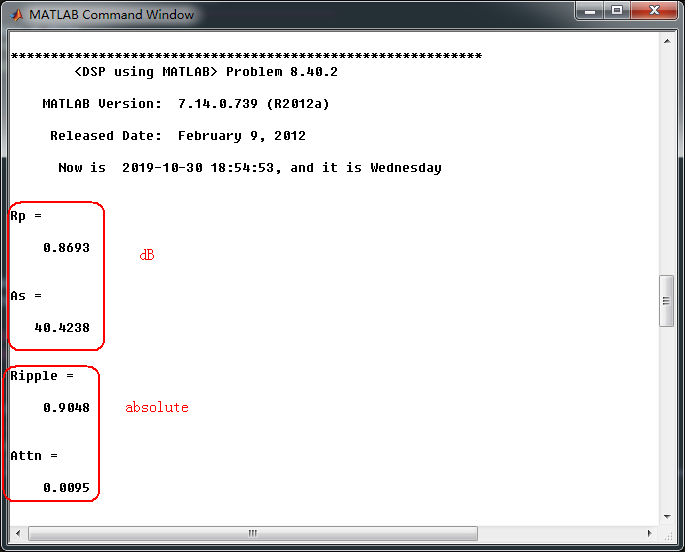
采用cheb1bsf函数,得到Chebyshev-1型数字带阻滤波器,系统函数直接形式的系数如下
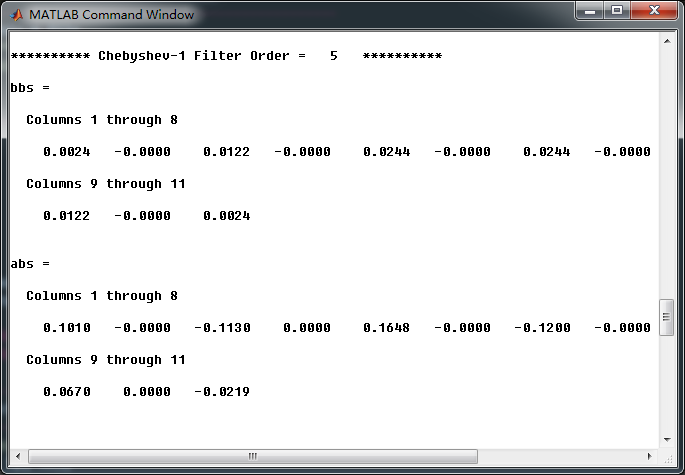
转换成串联形式,系数如下
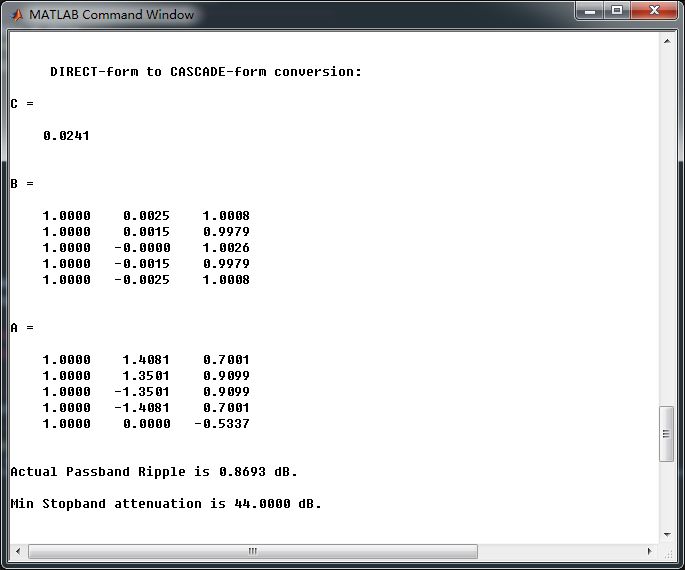
幅度谱、相位谱和群延迟响应
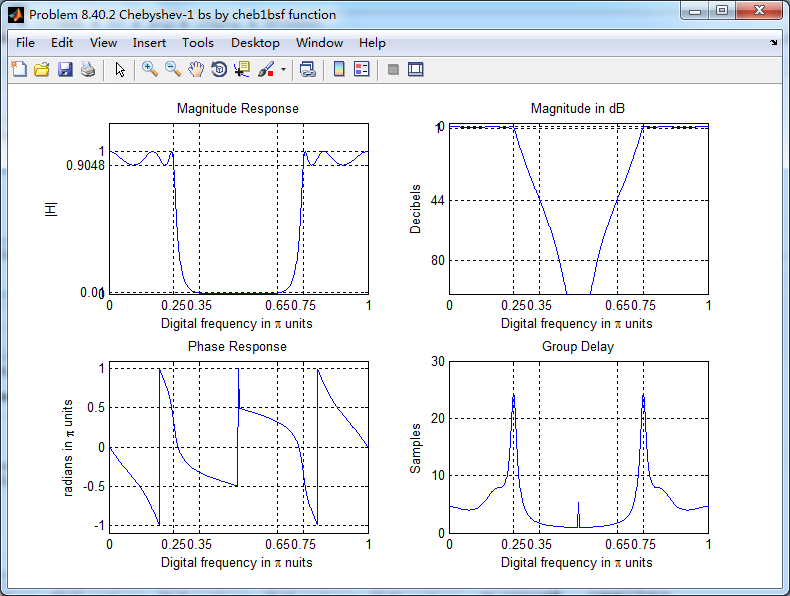
数字带阻滤波器零极点图
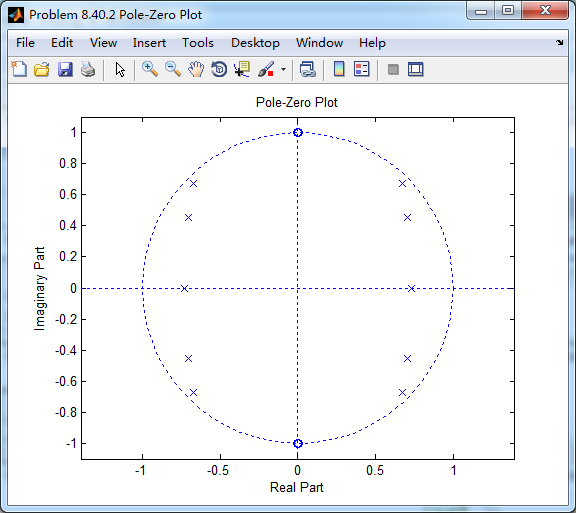
和P8.39进行对比,采用cheby1函数(MATLAB工具箱函数),计算得到数字带阻滤波器,系统函数直接形式的系数如下

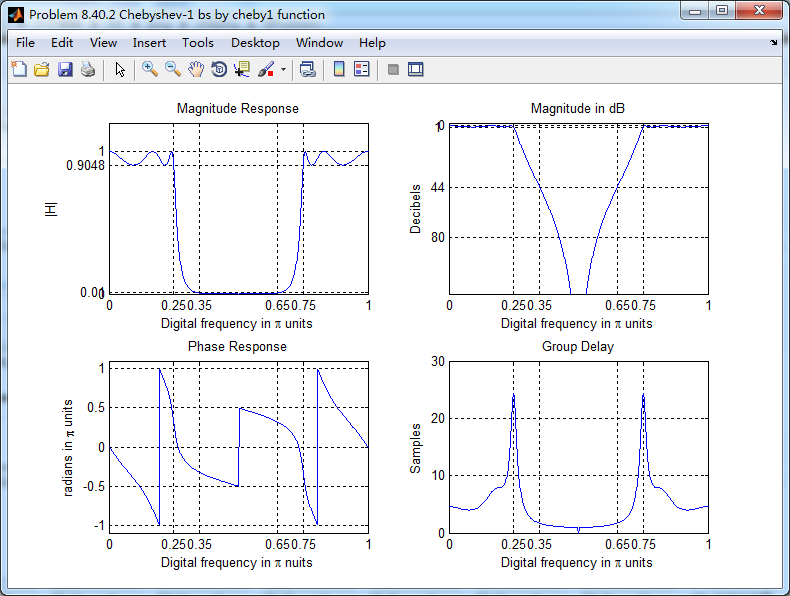
《DSP using MATLAB》Problem 8.40的更多相关文章
- 《DSP using MATLAB》Problem 7.27
代码: %% ++++++++++++++++++++++++++++++++++++++++++++++++++++++++++++++++++++++++++++++++ %% Output In ...
- 《DSP using MATLAB》Problem 7.23
%% ++++++++++++++++++++++++++++++++++++++++++++++++++++++++++++++++++++++++++++++++ %% Output Info a ...
- 《DSP using MATLAB》Problem 7.16
使用一种固定窗函数法设计带通滤波器. 代码: %% ++++++++++++++++++++++++++++++++++++++++++++++++++++++++++++++++++++++++++ ...
- 《DSP using MATLAB》Problem 7.9
代码: %% ++++++++++++++++++++++++++++++++++++++++++++++++++++++++++++++++++++++++++++++++ %% Output In ...
- 《DSP using MATLAB》Problem 7.6
代码: 子函数ampl_res function [Hr,w,P,L] = ampl_res(h); % % function [Hr,w,P,L] = Ampl_res(h) % Computes ...
- 《DSP using MATLAB》Problem 5.38
代码: %% ++++++++++++++++++++++++++++++++++++++++++++++++++++++++++++++++++++++++++++++++ %% Output In ...
- 《DSP using MATLAB》Problem 5.19
代码: function [X1k, X2k] = real2dft(x1, x2, N) %% --------------------------------------------------- ...
- 《DSP using MATLAB》Problem 5.10
代码: 第1小题: %% ++++++++++++++++++++++++++++++++++++++++++++++++++++++++++++++++++++++++++++++++ %% Out ...
- 《DSP using MATLAB》Problem 5.5
代码: %% ++++++++++++++++++++++++++++++++++++++++++++++++++++++++++++++++++++++++++++++++ %% Output In ...
随机推荐
- Oracle 、MySql 数据库表被锁的原因分析
记录一次准备给客户预演示出现的问题 事故的背景: 当所以功能开发完成后,开发人员在本地进行了测视已经没问题了.就把所有开发的功能模块合并到 dev 分支,进行打包,发布到预演示的线上环境.当在给相关人 ...
- 线性筛积性函数+反演T套路——bzoj4407
#include<bits/stdc++.h> using namespace std; #define ll long long #define mod 1000000007 #defi ...
- delphi 获取所有窗口标题
unit Unit1; interface usesWindows, Messages, SysUtils, Variants, Classes, Graphics, Controls, Forms, ...
- weblux上传图片
我是接口接收图片然后上传到阿里云上,由于引入的是spring weblux,所以使用方式不同,代码如下 @PostMapping(value = "/upload", consum ...
- (转)Python之路,Day6 - 面向对象学习
本节内容: 面向对象编程介绍 为什么要用面向对象进行开发? 面向对象的特性:封装.继承.多态 类.方法. 引子 你现在是一家游戏公司的开发人员,现在需要你开发一款叫做<人狗大战> ...
- 实战CGLib系列之proxy篇(一):方法拦截MethodInterceptor
实战CGLib系列文章 本篇介绍通过MethodInterceptor和Enhancer实现一个动态代理. 一.首先说一下JDK中的动态代理: JDK中的动态代理是通过反射类Proxy以及Invoca ...
- Altium Designer 精心总结(转)
https://blog.csdn.net/qq_29350001/article/details/52199356 设置铺铜间距规则,Electrical-Clearence_Poly设置如下,是铺 ...
- PAT_A1004#Counting Leaves
Source: PAT A1004 Counting Leaves (30 分) Description: A family hierarchy is usually presented by a p ...
- SpringMVC(day1搭建SpringWebMvc项目)
MVC和webMVC的区别 Model(模型) 数据模型,提供要展示的数据,因此包含数据和行为,行为是用来处理这些数据的.不过现在一般都分离开来:Value Object(数据) 和 服务层(行为). ...
- Python3入门机器学习经典算法与应用✍✍✍
Python3入门机器学习经典算法与应用 整个课程都看完了,这个课程的分享可以往下看,下面有链接,之前做java开发也做了一些年头,也分享下自己看这个视频的感受,单论单个知识点课程本身没问题,大家看的 ...
